The individual instructions only change the media player defaults for one single file type. You can actually set different file types to play with different players. This is especially useful if you use a specific program to play MIDI or MP3 files, which aren’t supported by all applications in Linux yet.
Method 1: Right-clicking on Media Files
If you already know where to find the audio or video file you want to play and can find it in your file manager, then just right-click on it and select Properties from the context menu. You should see a line called “Open With:” which will feature a drop-down box next to it. Click on the box and you’ll see a list of valid media players that you could view the file with. Select the one you’re looking for and then click on the Close or OK buttons, depending on which file manager you’re using. This should work just fine for those using Nautilus as well as those using a file manager under KDE. Thunar and PCManFM are also supported, so you shouldn’t have an issue if you’re using Xubuntu or Lubuntu either. You can now double click on the media file to play it in your preferred media player.
If the list doesn’t offer any other media players then the one it defaulted it, then it’s quite possible that you don’t have any others installed.
Method 2: Changing Default Applications
If you don’t have a media file picked out, then you’ll need to do one extra step but you still shouldn’t have to play around very much to get the job done. These instructions will change your default media player across your desktop environment for all file types, but this can easily be undone so you won’t do any lasting damage if you pick the wrong one. You’ll need to open the Default Applications configuration applet. Users of the Ubuntu Dash will want to select System Settings, click on Details and then click on Default Applications. Older versions of Ubuntu stored this in System Settings under System Info, and there may be a similar applet found for MATE users and the like. Xfce4 users won’t have to worry because that desktop environment primarily uses the above method for setting file associations. If you’re an LXDE user, then you’ll want to click on the LX Menu followed by Preferences and select Default Applications for LXSession. Regardless of what you did to get there, once you’re there scroll down until you see Video and Audio player options. Depending on your desktop environment, you may just see a blanket media player option.
Select your preferred media player and then agree to the changes if necessary. Close the window and you should have your preferred media player mapped across the board. You can try double clicking on any media file to test it out.
Your chosen media file will load in whatever media player you selected. Simply run the Default Applications selector through a second time if you want to change it again. You might need to do this after you install a new media player, since your package manager may force a change on you without your permission. If this ever happens, then merely open up the applet as is described in this method and select a different media player.
Psyonix Granting Refunds to Mac and Linux Rocket League PlayersWindows 10 Now Has Arch Linux Along With Ubuntu, SUSE And Other Complete Linux…Linux Mint 20 “Ulyana” An All 64-Bit Linux OS Based On Ubuntu 20.04 Stable…2K Advises Players to Change Credentials After Malicious Data Breach


